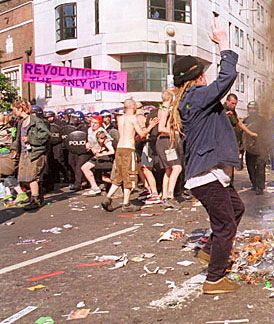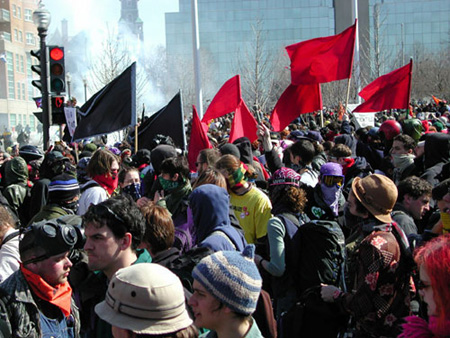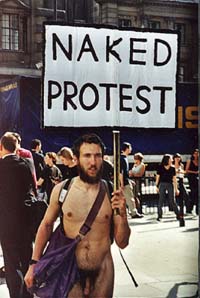The Revenge of the Concept: Artistic Exchanges, Networked Resistance
Author: Brian Holmes
I
Among the events of recent history, few have been as surprising, as full of enigmas, as the coordinated world demonstrations known as the Global Days of Action. Immediately upon their appearance, they overflowed the organization that had called them into being: the People's Global Action (PGA), founded in Geneva in February of 1998. [1] This transnational network of resistance had adopted a new concept of solidarity advanced by the Zapatistas, who encouraged everyone to take direct action at home, against the system of exploitation and oppression which they described as neoliberalism. As early as the month of May, 1998, the PGA helped spark demonstrations against the WTO whose effectiveness lay both in their simultaneity and in their extreme diversity: street parties in some 30 cities around the world, on May 16; four days of protest and rioting in Geneva, beginning that same day; a 50,000-strong march that reached Brasilia on May 20; protests all over India after a huge demonstration in Hyderabad against the WTO on May 2. The following year, London Reclaim the Streets launched the idea of a "carnival against capital" in financial centers across the world for the day of the G8 summit, June 18: there were actions in over 40 cities, including a ten-thousand-strong "carnival of the oppressed" by Niger Delta peoples against transnational oil companies. In the face of transnational capitalism, a networked resistance was born, local and global, tactical and strategic: a new kind of political dissidence, self-organized and anarchist, diffusely interconnected and operating only from below, yet able to strike at the greatest concentrations of power. What is the strength of such movements? The improbable and serious appeal to a "do-it-yourself geopolitics": a chance for personal involvement in the transformation of the world.

These kinds of actions are about as far as one could imagine from a museum; yet when you approach them, you can feel something distinctly artistic. They bring together the multiplicity of individual expression and the unity of a collective will. That is their enigma, which sets up a circulation between art and solidarity, cooperation and freedom. But this enigma stretches further, into the paradoxes of a networked resistance. Because since their surprising beginnings, we have seen the movements change, we have seen them globalize. Activists from the South and the North travel across the earth in jet planes, to demonstrate next to people without money, without work, without land or papers – but who may know the same writers, the same philosophers, the same critiques of contemporary capitalism. The intensive use of Internet by the movement of movements means that dissenting messages take the pathways used by financial speculation. Sometime you wonder whether the two can even be distinguished. What are the sources of this networked resistance? And what exactly is being resisted? Is revolution really the only option – as one could read on a banner at the carnival against capital, on June 18, 1999, in the financial center of London? Or do we not become what we resist? Are the "multitudes" the very origin and driving force of capitalist globalization, as some theorists believe? [2]
Two British critics, Anthony Davies and Simon Ford, posed exactly those questions, with direct reference to art. They pointed to the way that artistic practice was tending to integrate with London's financial economy, particularly through the vector of specially designed "culture clubs" where artists sought new forms of sponsorship and distribution, while businessmen looked for clues on how to restructure their hierarchical organizations into cooperative teams of creative, autonomous individuals: "We are witnessing the birth of an alliance culture that collapses the distinctions between companies, nation states, governments, private individuals – even the protest movement," the two critics claimed.[3] They perceptively drew a link between contemporary artistic experiments – those dealing with the use and appropriation of complex signs and tools, or with the catalysis of interactions between free individuals – and the politicized street parties of the late 1990s. But their analysis opposed these new movements, not to transnational capitalism, but to the outdated world of pyramid-shaped hierarchical organizations. Thus their image of the June 18 carnival: "On the one hand you have a networked coalition of semi-autonomous groups and on the other, the hierarchical command and control structure of the City of London police force. Informal networks are also replacing older political groups based on formal rules and fixed organizational structures and chains of command. The emergence of a decentralized transnational network-based protest movement represents a significant threat to those sectors that are slow in shifting from local and centralized hierarchical bureaucracies to flat, networked organizations."
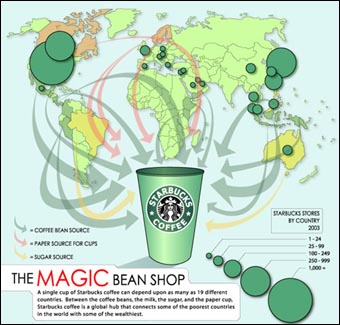
Conceived at the outset of the year 2000, this alliance theory was mainly concerned with distinguishing a "new economy" from the old one. It combined a network paradigm of organization, as promoted by Manuel Castells, [4] with a description of the culturalization of the economy, as in British cultural studies. But what it demonstrated was more like an "economization of culture." Everything seemed to be swirling together: "In a networked culture, the topographical metaphor of 'inside' and 'outside' has become increasingly untenable. As all sectors loosen their physical structures, flatten out, form alliances and dispense with tangible centers, the oppositionality that has characterized previous forms of protest and resistance is finished as a useful model."
These kinds of remarks, which came from many quarters, were already confusing for the movements. But they took on an even more troubling light when the Al Qaeda network literally exploded into world consciousness. On the one hand, the unprecedented effectiveness of the S11 action seemed to prove the superiority of the networked paradigm over the command hierarchies associated with the Pentagon and the Twin Towers. But at the same time, if any position could be called "oppositional," it was now that of the Islamic fundamentalists. Their successful attack appeared to validate both the theory of a decisive transformation in organizational structures, and Samuel Huntington's theory of the "clash of civilizations." Suddenly the protest movement could identify neither with the revolutionary form of the network, nor with the oppositional refusal of the capitalist system. Loud voices from the right immediately seized the opportunity to assimilate the movement to terrorism. And to make matters worse, the financial collapse that the movement had predicted effectively happened, from the summer of 2000 onwards, casting suspicion over everything associated with the dot-com bubble – including all the progress in democratic communication. At the same time, the secret services of the most powerful countries, and especially the US, declared themselves ready to meet the challenge of the networks, by giving themselves new capacities for autonomy, horizontality, interlinkage.[5] The difficulty of situating a networked resistance to capitalism within a broader spectrum of social forces thus became enormous – as it still is today.
This difficulty has not stopped the mobilizations. But what has come to a halt, or splintered into a state of extreme dispersal, are the theoretical attempts to analyze them in a way that can contribute something to their goals and capacities of self-organization. What I want to do here is to make a fresh try at this, from an anthropological viewpoint that can distinguish between the fictions of a "self-regulated market" and the reciprocities and solidarities that make it possible to live together as human beings. So we'll begin with a social and economic study of the vital need for resistance to the crises of capitalism. We will then see how this resistance can develop within the contemporary technical environment. And finally, returning to the question of alliance or opposition, we will look at some of the contributions that artistic practice makes to this networked resistance, by rediscovering languages that seemed to have been consigned to the museum. I am thinking primarily of conceptual art: a practice that doesn't produce works, but only virtualities, which can then be actualized, at each time and in each place, as unique performances.
II
Following the Zapatistas, people in the movement of movements tend to call the current economic structure "neoliberal." But the word evokes a political philosophy stretching back to the eighteenth century. One can speak instead of flexible accumulation, which describes the computer-linked, finance-driven, just-in-time model of the globalized economy.[6] By subordinating the other spheres of social life – education, science, culture, etc. – this organization of production and consumption produces a veritable hegemony, a mode of regulation for society as a whole. To grasp the way this hegemony is experienced by individuals, I have proposed the notion of the flexible personality.[7] It is an ambiguous notion: because although it primarily designates the managerial culture that legitimates the globalized economy, and that renders it tolerable or even attractive for those who are its privileged subjects, it also recalls the profound opportunism that this organization demands, as well as the "flexible" nature of the workforce that it subjects to increasingly individualized forms of exploitation. The flexible personality designates the lived experience of a relation of domination. It is essential to define its limits.
One can begin to do so by pointing to the different kinds of social struggles that have intensified over the last ten years. Ecological struggles, against resource waste, polluting industry, invasive infrastructures. Workers' struggles, against falling wages, worsening labor conditions, insufficient health coverage or unemployment benefits. Struggles against the privatization of medical and scientific knowledge, against the control of the university and of cultural production by business. And finally, struggles against the preponderance of the financial sphere in the taking of democratic decisions. This list of different fields of struggle refers us, in a more abstract way, to four "fictive commodities": land, labor, knowledge and money itself. That is, four major articulations of social life which capitalism claims to treat as things to be sold, confiding their destiny to the operations of a self-regulating market.[8] The problem being that the basic conditions under which these "things" are produced do not all have a price tag, and so escape any monetary regulation. These four major articulations of society exist at least partially outside the market: they are "externalities."[9] And the maintenance of their fictive status as commodities implies a perpetually deferred cost, which in the long run can only manifest itself in a phenomenon outside any imaginable accounting. This is the phenomenon of systemic crisis. Its looming shadow has motivated the increasing levels of social struggle.
It was an anthropologist, Karl Polanyi, who provided the most striking description of a systemic crisis, in a book called The Great Transformation, published in 1944. The story begins with the enclosure of community pasture lands in England, known as commons, which were transformed with fences into private property. This privatization of resources led to the appearance of rural poverty in the course of the eighteenth century. The threat of famine then made possible an unprecedented exploitation of labor power, which former peasants were compelled to sell for a bare minimum in the new factories of the Industrial Revolution. In this way, the owning class accumulated great fortunes, which split away from the nationally instituted money to employ the international currency of gold bullion. Polanyi pays special attention to demonstrating the directive role that independent bankers played in the creation of the gold standard, which served as a universal, but legally private equivalent between all the different national currencies. He shows that a cycle of three privatizations – land, labor, and money – leads finally to the worldwide market of the nineteenth century.
For a hundred years, gold served as a coherent and relatively stable language of exchange for commercial transactions; and the profits were a powerful argument in favor of peace, or at least, against generalized warfare. It was the gradual abandonment of the international gold standard under the pressure of repeated financial breakdowns that led, in the 1930s, to the reconstitution of strictly national economies, closed in on themselves and subject to various forms of central planning (ranging from the relatively benign New Deal, to Nazism and Stalinism). But Polanyi, writing in 1944, did not suggest anything as simplistic as restoring the gold standard. His strongest argument was that the violence of free-market exchanges, when "disembedded" from their place within the larger social structure of reciprocities and solidarities, was finally what destroyed the laissez-faire system itself, provoking the fascist reaction. The fundamental problem therefore lay with the very notion of the self-regulating market. The last chapter of The Great Transformation predicts the opening of a new era in the history of humanity. It calls for the institution of a mixed economy, broadly regulated within a national framework and yet also highly respectful of individual rights, able to guarantee what the author describes as "freedom in a complex society" – that is, in a society which has recognized the limits of the free market.
The Keynesian welfare state of the post-war period could appear as an answer to Polanyi's vision. It submitted industrial and financial activity to a social regulation, conceived within each national framework in a more or less democratic fashion. But the dynamics of capitalism rapidly overflowed this national frame, as one can see in the evolution of the world monetary system. After the war, the Bretton Woods treaty tied signatory countries into a system of relatively stable exchange rates, whereby all the currencies were pegged to the dollar, which in turn was convertible into gold. But this system proved untenable, and after the United States suspended convertibility in 1971, the currencies began to "float" against each other; since the outset of the eighties they have been subject to the fluctuations of a highly speculative exchange market, operating at the speed of computers and telecommunications. At the same time, controls on crossborder investments have gradually been lifted, and many state services and industries, considered as unfair competition with the private sector, have been suppressed. In a world which no longer erects any significant barriers to the directive capacity of money, capital flow into the stock markets now commands the majority of productive investments everywhere; and every material reality comes to be dependent on highly volatile financial information. In this way there arises what Rem Koolhaas has called "the world of ¥ € $": a world-economy built around the incessantly changing equivalence of the yen, the euro, and the dollar, representing the three major poles of world prosperity. One can see the convertibility of these three currencies as a new kind of economic language, serving primarily to convey the opportunistic speech of private investors, indeed, of a transnational capitalist class. ¥ € $ is the monetary language of the flexible personality.
The last twenty years have seen the incredible inventiveness of this worldwide language, which has generated a myriad of private dialects: stocks, futures, options, swaptions, floaters, hedges, and so on through the endless list of derivatives. Despite their appearance of total autonomy, of absolute disconnection from the solid earth, these forms of privately managed credit money have directed the productive apparatus of the world's countries, ever more radically since 1989. In parallel to these developments in the private sphere, a new type of postnational state has slowly come into being, abandoning the former emphasis on social security and public welfare, and seeking instead to encourage the insertion of its most innovative citizens into the worldwide information economy.[10] And the language of ¥ € $ has also taken on cultural, intellectual, organizational and imaginary forms, giving rise to artistic productions, managerial techniques, modes of behaviors, desires and dreams that have served to legitimate the regime of flexible accumulation, while continually feeding it with new innovations. But this very inventiveness, this speculative confidence, has also gnawed away at the ecological, social, political, and financial foundations of the system. We went through the Asian crisis of 1997, which spread to Russia and Brazil, threatening even the American economy; then came the krach of the NASDAQ in spring 2000, sparking a two-year plunge of the world's stock markets (which remain extremely volatile at the date of writing, three years later). The possibility of a systemic crisis, which could be seen on the horizon throughout the 1990s, has rushed suddenly closer at the outset of the new millennium.
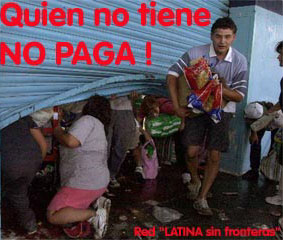
What are the effects of the crisis as it stands today? One can draw a few insights from recent developments in Argentina. In the late 1990s the Argentine state, under pressure from the IMF, desperately attempted to maintain the value of the peso with respect to the dollar, and more broadly, with respect to the standard of prosperity represented by the currencies of ¥ € $. A series of structural adjustments were supposed to improve the economy's health, and insure the continuing parity of the peso and the dollar; but their effect was to exclude increasing numbers of Argentines from access to employment, basic services, food, and finally even to their money, when bank withdrawals were frozen in late November 2001. Thus the state's maintenance of the peso's exchange value, ensuring the integration of the country's elite to the world economy, no longer permitted any use value on the local level. Resistance now became a question of sheer survival, and some Argentines spoke of a crisis in the very process of civilization: "The new state project implies, in the short term, an abrupt cut-off... of the systems of social reproduction: the state gradually detaches itself from the populations and the territories; and finally, from social cohesion itself."[11] But this detachment only gives the state the power of an empty affirmation, an entirely formal language of exchange, which is valid in theory but not in fact. And the void calls out either for a democratic invention, or for an authoritarian solution.
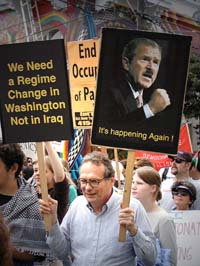
This situation of suspended crisis appears likely to spread, leaving open, at least for a time, the possibility of very different responses. The illusions of the 1990s, however, are definitely over. The collapse of the stock markets, and the economic slowdown that has followed, brings a threat of deflation, unemployment and exclusion to bear on most of the world's populations. Under current political conditions, the only possible response seems to be a strengthening of the barriers that separate the privileged classes from all the others – and this, even within the richest countries. The new military posture of the United States, while directly motivated by the September 11 attacks, also represents an attempt to restructure society, and to institute a new form of discipline in the face of the void that has been left by the collapse of the speculative bubble. It is in this way that the ideological version of economic flexibility meets its own limits. This shift toward heightened military and police control takes away much of the legitimacy that flexible modes of management were able to confer on capitalist society. Still the opportunistic model of the flexible personality will probably continue to orient the behavior of privileged individuals for years yet to come, even as it subjects them to strong contradictions. Under such conditions, the various forms of resistance to capitalism will clearly intensify, not least because they find a vital energy in the feeling of absolute necessity brought on by the crisis. Now I want to deal specifically with one such form of resistance: the resistance to the privatization of knowledge, the fourth "fictive commodity" whose importance Polanyi had not yet measured. It is through the cooperative production of immaterial knowledge that we will rejoin the enigma of the networked protests.
Just one more thing. I do not want to accord any privilege, in what follows, to that supposedly more "advanced" fraction of the world population which is so deeply involved with electronic networks. I think the opposition between the "Net" and "Self" – between a modernizing process that enforces our abstraction from historical ad cultural traditions, or failing that, determines a desperate and regressive retreat to the fixations of local identity – is simply false.[12] More interesting is the divide between the possessive individualism of the flexible personality, and a concern for human coexistence. As we saw above, the movement of movements found one of its beginnings in a concept of solidarity arising from the Zapatista struggles, which have fundamentally to do with questions of land. But the meaning of these survival struggles of the Mayan peoples could only reach the subjects of the developed world through the Internet, where the commodification of cultural and scientific knowledge is at stake. Here the essential struggle is to overtake and dissolve the language of ¥ € $, not through a return to the closed, bureaucratic frameworks of the Keynesian state, but instead through the political development of new principles of exchange and reciprocity. Thus this fourth field of resistance, with touches closely on human language but also on technical development, seems destined to furnish elements of articulation for other struggles, in a shared search for alternatives to the systemic crisis.
III
It is well known that the Linux operating-system kernel, and free software generally, is made cooperatively without any money changing hands. This is something that quickly caught the attention of artists and culture critics, as in the discussions over what Richard Barbrook called the "high-tech gift economy."[13] The expression recalls an anthropologist, not Polanyi but Marcel Mauss, the author of the famous essay on The Gift. His essential contribution was to underscore, at the very heart of modern economic exchange, the presence of motives irreducible to the calculation of the value of material objects, and also of the individual interest one might have in possessing them. As Barbrook points out, the heritage of Mauss was very much alive in alternative circles, his ideas having inspired the Situationists, who passed them on to the do-it-yourself media ethic of the Punk movement. But mostly what fueled the discussion of the Internet gift economy was not theory, but the simple practice of adding information to the net. As Rishab Aiyer Ghosh explained, "the economy of the Net begins to look like a vast tribal cooking-pot, surging with production to match consumption, simply because everyone understands – instinctively, perhaps – that trade need not occur in single transactions of barter, and that one product can be exchanged for millions at a time. The cooking-pot keeps boiling because people keep putting in things as they themselves, and others, take things out."[14] By placing the accent on the overflowing abundance and free nature of the available content, Ghosh responded implicitly to one of the most contested themes in Mauss's essay, which cast each gift as the deliberate imposition of a debt on the receiver, instating hierarchies which were quite foreign to the practice of networked information exchange.

Today, with the popular explosion of Gnutella and other peer-to-peer file-sharing systems, these notions of the high-tech gift economy have begun to form part of common sense. It seems to admit at least a few new things: that the coded creations circulating on the Internet are never "consumed" like a cigarette would be; that use by some people in no way limits their availability for others; and that certain kinds of exchanges therefore have nothing to do with rarity and are quite possible without money. What is less often remarked, because of a denial which is characteristic of free-market rhetoric, is the fact that non-monetary models of exchange have been operating on a very large scale for as long as one can remember, for instance in the realm of academic publishing, where the primary motive for sharing information is not its monetary value but the recognition it brings – a recognition which itself is at least partially dependent on the idea of contributing something to humanity or truth. In fact there exists quite a large movement in the domain of scientific publishing aiming for online release of all the articles carried by specialized journals, in order to make the results universally accessible despite the increasing cost of many essential print publications.[15] Recently, an author by the name of Yochai Benkler has taken the twin examples of free software and academic publishing as a foundation on which to build a general theory of what he calls "commons-based peer production," by which he means non-proprietary informational or cultural production, based on materials which are extremely low cost or inherently free. This voluntary form of self-organized production depends, in his words, "on very large aggregations of individuals independently scouring their information environment in search of opportunities to be creative in small or large increments. These individuals then self-identify for tasks and perform them for complex motivational reasons."[16] Benkler's first aim, however, is not to explain peoples' motivation, but simply to describe the organizational and technological conditions that make this cooperative production possible.
Four attributes of the networked information economy appear as preconditions of commons-based peer production. First, information must be freely available as inexhaustible raw material for products which, in their turn, will become inexhaustible raw materials for further productions. Second, potential collaborators must be easily able to find the project that inspires them to creativity and labor. Third, the cost of production equipment must be low, as is now the case for things like computers and related media devices. Fourth, it must be possible to broadly distribute the results, for instance, over a telecommunications net. Under these conditions, quite complex tasks can be imagined, divided into small modules, and thrown out into the public realm where individuals will self-identify their competency to meet any given challenge. The only remaining requirement for large-scale production of cultural and informational goods is to be able to perform quality checks and integrate all the individual modules with relatively low effort into a completed whole – but these tasks, it turns out, can often be done on a distributed basis as well. The fact that all of this is possible, and actually happening today, allows Benkler to contradict Ronald Coase's classic theory, which identifies the firm, with its hierarchical command structure, and the market, functioning through the individual's quest for the lowest price, as the only two viable ways to organize human production. In other words, in the cultural and informational domain there is an alternative mode of production, functioning outside the norms of the state-capitalist economy as we know it, but without any rhetorical need to proclaim a clean break or an absolute division between them.
The notion of the commons refers back to the same pre-capitalist history that Polanyi had invoked; and it does so in the context of what some are calling the "second enclosure movement," resulting in the extension of intellectual property rights, or the privatization of information. Benkler stresses that the word "commons" denotes "the absence of exclusion as the organizing feature of this new mode of production." To be sure, the examples he uses to prove the existence of voluntarily organized large-scale cultural production are strictly electronic projects like the Wikipedia encyclopedia, the Slashdot technews site, the Kuro5hin site, and so on. These are essentially situations where publicly available text plus creativity produces more publicly available text. They are also politically neutral examples, appropriate for an argumentation that aims, among other things, to influence the American legislature on the subject of copyright laws. Yet one could apply exactly the same ideas to the growing phenomenon of networked political protests. It is clear that mass access to email and the possibility to create personal web pages – both of which have been quite necessary to the world expansion of liberal capitalism – almost immediately made possible, not only a greater awareness of globalization and its effects, but also the self-organization of dissenting movements on a world scale. And the scope of the projects that have been realized in this sense has been tremendous.
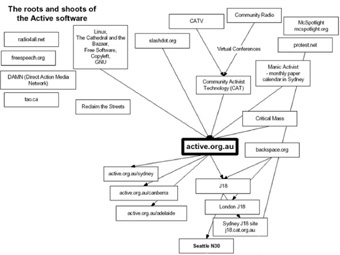
Just reflect for a moment on what each of the major "counter-globalization" actions has involved. Collaborative research on the political, social, cultural, and ecological issues at stake. Various levels of coordination between a wide range of already constituted groups, concerning the preliminary forms of mobilization. Worldwide dissemination, through every possible channel, of the research and preliminary positions. Travel of tens or hundreds of thousands of single persons and autonomous groups to a given place. Self-organization of meeting and sleeping places. Intellectual and political cooperation on some form of counter-summit. The creation of artistic and cultural events in the spirit of the movements. A minimal agreement, worked out beforehand or in the heat of the moment, on the specific forms and places of the symbolic and direct actions to be undertaken. Legal and medical coordination in order to ensure the demonstrators' security. The installation of communications systems allowing for the transmission of precise yet exceedingly diverse coverage of the events. A social, legal, and political follow-up of the aftermath. Finally, a subsequent analysis of the new situation that results from each confrontation: in other words, a new starting-point.
In this sense one could say that, just like the projects of commons-based peer production, these mobilizations begin and end with the fabrication of publicly available texts. For example, the People's Summit in Quebec City in April 2001 began long in advance, with many different studies of the consequences to be expected from the future agreement on the Free Trade Area of the Americas. These studies led to the drafting of a remarkable document, "Alternatives for the Americas," which is a counter-treaty of great precision, composed through a process of knowledge exchange and political coordination on the scale of the American hemisphere.[17] It's also true that as a direct consequence of the massive demonstration that took place during the summit, the official working draft of the FTAA treaty was made public for the first time; until then it had not even been available to elected representatives of the American peoples, but only to executive negotiating teams (and scores of corporate "advisers"). In this way the counter-globalization movements constitute a public archive. And yet between the fundamental landmarks represented by these text publications, how many face-to-face debates took place, how many moments of singular or collective creation, how many acts of courage and solidarity? And how many emotions, images, memories, and desires were created and shared during the days of action in Quebec City?
The spectacle of these great gatherings, overflowing with freely given creations, could appear like a new form of the potlatch ceremonies described by Marcel Mauss, a gift-giving ritual where the demonstrators try to outdo their adversaries through open displays of generosity. No doubt there is something of that, which explains why the words "free" and "priceless" have been so important in these demonstrations. But what seems more interesting in the reference to Mauss is his way of perceiving gift-giving rituals as "total social facts," bringing all the different aspects of social life together in a system of complex and indivisible relations. Whoever saw the extraordinary symbolic transactions between pacifists, ecologists, unionists, anarchists, spirtualists, delinquents, reporters, by-passers, cops and politicians at the G8 summit in Genoa, in July of 2001, can find a real resonance in what Mauss says about the Melanesian gift-giving ceremonies, the American Indian potlatch rituals, and the "market-festivals of the Indo-European world":
"All these phenomena are at once legal, economic, religious, and even aesthetic, morphological, etc. They are legal, including public and private law, diffuse and organized morality; they are strictly obligatory or simply praised and blamed, political and domestic at the same time, involving the social classes as well as the clans and families. They are religious: including strict religion and magic and animism and diffuse religious mentality. They are economical: because the idea of value, of utility, of interest, of luxury, of wealth, of acquisition and accumulation as well as consumption and even purely sumptuary expenditure are everywhere in them, even though these are all understood differently than by us today. What is more, these institutions have an important aesthetic side to them... the dances that are carried out alternatively, the chants and parades of all kinds, the dramatic performances... everything, food, objects, and services, even "respect," as the Tlingits say, everything is a cause for aesthetic emotion."[18]
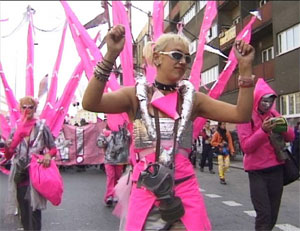
There is no nostalgia for a primitive life in the fact of quoting Mauss, nor any facile admiration for the "revolutionary fête." Things are much more complex. On the one hand, the contemporary quest for "direct action," for "direct democracy," finds an initial realization in the collective, cooperative production of these public events, which bring together all the rigorously separated aspects of modern social life. Indeed, the very aim of such events is to criticize certain fundamental separations, like the one that amputates any basic concern for life from the laws of monetary accumulation. But that doesn't mean that the event, the ecstatic convergence, is a total solution: instead it is a departure point for a fresh questioning of the social tie, at times when its deadly aspects become visible, as they are today. The protestors' claim, not just to the occupation but to the creation of public space, with all the conflicts it brings in its wake, offers society an occasion to theatricalize the real, in order to replay the meaning of abstractions that are no longer adequate to the needs and possibilities of life. The "total social fact" of the contemporary demonstration is, at its best, a chance to relearn and recreate a language for political debate, which isn't just about money, and doesn't only have "¥ € $" in its vocabulary. And the networked protests we are speaking of, including those of the peace movement in 2003, have produced the first chances to do this at the scale of the globalized economy and of global governance.
Artistic practice has been one of the keys to the emergence of these "global social facts" – not least because artistic practice has also been one of the ways to hold off group violence, to open up a theatrical space that doesn't immediately become a war zone. This is obviously something that contemporary society risks forgetting, and that particular risk is reason enough in itself to go beyond the specialized, disciplinary definition of art, to try to relocate art within a much broader political economy. Before I do that, however, I want to draw one last group of ideas from Yochai Benkler. His paper closes with the problem of what he calls "threats to motivation." One of these comes from the failure to integrate the results of commons-based peer production into usable wholes which can make a project successful. Translated into political terms, this would mean the failure of the networked movements to change any tangible aspect of social life. That is a real threat to motivation; and I think it's vitally important to keep offering practical ideas and proposals about possible changes on all the scales of governance and existence, from the neighborhood to the world level, at every new demonstration. Benkler points to different strategies for putting together the results of common effort. These strategies range from self-organization of the integration process, to the delegation of this tricky point to a hierarchical structure or a commercial enterprise. Again the translation into our terms is obvious, and has become increasingly visible at events such as the European Social Forum, held in Florence in November of 2002. Just when the networked struggles get big enough to succeed, there is an enormous temptation to hand them over, in the name of efficiency, to a traditional politburo supported by professional media people. The problem with such expedient strategies is that they risk giving participants the impression that the voluntary production of political culture with their peers is being confiscated by somebody in a directive position. A fantastic example of this is the 30-thousand member ATTAC association in France, which, to the discontent of many members, is in fact a strictly controlled hierarchical organization at the national level. However, for ATTAC to have the social power it does, it has also had to produce a decentralized network of local committees, which operate very differently from the national bureau and regularly criticize or contradict its decisions. The tension you can see there in a very real situation, between collective process and effective decision, is at the heart of the democratic experiment today. You might even say that working though that kind of tension is the art of politics.
IV
So now we return to the language of art, and to an art whose very essence is language. Obviously I'm talking about conceptual art. But today this most revolutionary of all art forms is considered a failure. The "escape strategies" that Lucy Lippard talks about in her famous book on The Dematerialization of the Art Object were intended to free artists from dependency on the gallery-magazine-museum circuit. It was thought that artists could motivate people to use their imagination in completely new ways, by giving them linguistic suggestions, virtual proposals that they could actualize outside the specialized institutions. But exclusive signatures rapidly took precedence over the infinite permutation of the works in the lives of the viewers/users. The necessary corollary was that the concept should refer primarily to itself, as in a famous piece composed of a chair, a picture of a chair, and a dictionary definition of the word "chair" (Joseph Kosuth, One and Three Chairs, 1965). Such a work, completing itself in a tautology that required no transformative activity from the public, could easily be presented within the existing system. Thus the conceptual escape attempt only led from market-oriented New York to the museums of Europe, then finally back to the market. In 1973, Seth Siegelaub said in an interview: "Conceptual art, more than all previous types of art, questions the fundamental nature of art. Unhappily, the question is strictly limited to the exclusive domain of the fine arts. There is still the potential of it authorizing an examination of all that surrounds art, but in reality, conceptual artists are dedicated only to exploring avant-garde aesthetic problems.... The economic pattern associated with conceptual art is remarkably similar to that of other artistic movements: to purchase a work cheap and resell it at a high price. In short, speculation." [19] Lucy Lippard, for her part, wrote in 1973 that the "ghetto mentality predominant in the narrow and incestuous art world... with its reliance on a very small group of dealers, curators, editors and collectors who are all too frequently and often unknowingly bound by invisible apron strings to the 'real world's' power structures... make[s] it unlikely that conceptual art will be any better equipped to affect the world any differently than, or even as much as, its less ephemeral counterparts."[20]
These admissions of defeat are well known.[21] But in recent publications, another history of conceptual art has been coming back to light. It is a history that unfolds in Latin America, and particularly in Argentina, in the cities of Buenos Aires and Rosario. It would seem that here, in the context of an authoritarian government and under the pressure of American cultural imperialism, conceptual art could only be received – or invented – as an invitation to act antagonistically within the mass-media sphere. Certain Argentine pop artists considered that the commercial news media could actually be appropriated as an artistic medium, like a canvas or a gallery space. To do this, Roberto Jacoby and Eduardo Costa created an artificial happening, one that never really happened, and they stimulated the media with information about it, so as to achieve specific fictional effects.[22] But this attempt was only a first step towards a fully political appropriation of the communications media by artists. The most characteristic project was Tucumán Arde, or "Tucumán is Burning," realized in 1968.[23] The military government was attempting to "modernize" the sugar-cane industry in the province of Tucumán, with a shift from small, locally owned businesses to larger factories owned by foreign capital; at the same time, the official media painted an idyllic picture of a region which in reality was wracked by impoverishment and intense labor struggles. So a group of some thirty artists and intellectuals from Buenos Aires and Rosario researched the social and economic conditions in the province, carrying out an analysis of all the mass-media coverage of the region, and going out themselves to gather first-hand information and to document the situation using photography and film. They then staged an exhibition that was explicitly designed to feed their work back into the national debate, so as to counter the media picture. Yet the project, although it did not shy away from advertising techniques, could not be reduced to counter-propaganda. As Andrea Giunta writes: "In many of its characteristic traits – such as the exploration of the interaction between languages, the centrality of the activity required from the spectator, the unfinished character, the importance of the documentation, the dissolution of the idea of the author, and the questioning of the art system and the ideas that legitimate it – Tucumán Arde maintains a relation with the repertory of conceptual art. But not with the tautological and self-referential form of conceptualism, in which, from a certain viewpoint, one finds a reconfirmation of the modernist paradigm. Language does not refer back to language, to the specificity of the artistic fact; instead, the contextual relations are so strong that in this case, reality ceases being understood as a space of reflection and comes to be conceived as a possible field of action oriented toward the transformation of society."[24]
Tucumán Arde is extremely interesting to consider from the contemporary viewpoint of tactical media practice, which in many respects has been one long effort to research, expose, and go beyond the idyllic picture of globalization being painted by the corporate media.[25] But to understand the major differences from today's situation, one must realize that Tucumán Arde was done with the support of the Argentine CGT, that is, a radical labor union, and the exhibition was shown in a union hall. In other words, to obtain the funding and distribution of practices that would not be supported by the market, the Rosario group had to collaborate with a bureaucratic structure, which is essentially an outgrowth of the capitalist firm. And that is almost impossible today, at least in the overdeveloped countries. For complex reasons which have to do both with the anti-bureaucratic bias of the New Left, and with the heightened integration of labor unions to the state after the crisis of 1968, it has become very difficult for social movements, let alone artists, to collaborate with official structures such as parties, unions, etc. The motivation just isn't there. This is why the use of carefully conceived linguistic formulas, of oriented but open signifiers, would become a far more effective means of mobilization in the late 1990s, when ideas could be distributed and constantly transformed through the proliferation of connections offered by the Internet. In this way one achieved a non-bureaucratic capacity for subversive political action on a large scale, outside any compulsory framework. A new kind of conceptualism began to emerge, in which "attitudes become forms," as the curator Harald Szeeman said in the 1960s. An idea or phrase could become a world-wide event, in which every individual performance was different. Just as in Lawrence Weiner's famous prescription, the action could be carried out by the originators of the ideas, or realized by others, or not done at all. In the late 1990s, this revolutionary promise was realized. Thirty years after experiments such as Tucumán Arde, the counter-globalization movement burst onto the world scene as the revenge of the concept.
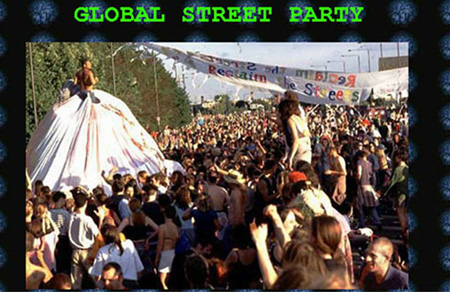
The examples of this revenge could be as numerous as the experiences of those involved in it. That is why I want to talk about an event in which I personally took part: the carnivalesque performance and riot in the City of London on June 18, 1999. Before it took place, this day was intensely dreamed by a multiplicity of actors, sometimes connected in constant dialogue and exchange, sometimes affected at a distance by signs that promised to break their isolation and unleash their agency. The inspiration first emerged, at least in certain versions of the story, during the summer of 1998 in conversations between members of London Reclaim the Streets and the anarchist group London Greenpeace (not the famous NGO).[26] It spread through the networks of Peoples' Global Action, drawing on the suggestive potency of two key ideas. One was the "street party," as a way to refuse the domination of the city by the automobile – and of democracy by traditional party politics. The other was the phrase "Our resistance is as transnational as capital": a return of twentieth-century internationalism in red, black, and green, after a long trip through the jungles of Chiapas where the Zapatista uprising began on January 1, 1994 (the day NAFTA came into being). A complex circulation through time and space, where solidarity means respect for local autonomy and differing motivations for struggle, was encapsulated in these two key ideas. A call to action, distributed widely through the Internet, put it like this:
"The proposal is to encourage as many movements and groups as possible to organize their own autonomous protests or actions, on the same day (June 18th), in the same geographical locations (financial/ corporate/ banking/ business districts) around the world. Events could take place at relevant sites, e.g. multinational company offices, local banks, stock exchanges. Each event would be organized autonomously and coordinated in each city or financial district by a variety of movements and groups. It is hoped that a whole range of different groups will take part, including workers, peasants, indigenous peoples, women, students, the landless, environmentalists, unwaged/unemployed and others....everyone who recognizes that the global capitalist system, based on the exploitation of people and the planet for the profit of a few, is at the root of our social and ecological troubles."[27]
J18 in London was the most exquisitely planned and spontaneously realized artistic performance in which I have taken part, an awakening to new possibilities of political struggle that would be echoed throughout the world. Thousands converged in the morning at the Liverpool tube station in the City, receiving carnival masks in four different colors that encouraged the crowd to split into groups, outwitting the police by following different paths through the medieval street plan of Europe's largest financial district, then coming together again in front of the LIFFE building, the London International Financial Futures and Options Exchange, which was the symbolic and real target of this protest against the global domination of speculative exchange. The choice of site was essential. Long years of effort by far-flung organizers and intellectuals had been required to understand and describe the ways in which capital had escaped its former national bounds, in order to redeploy itself transnationally in new oppressive systems; yet until the late 1990s, that knowledge remained largely abstract, floating in a deterritorialized space like the financial sphere itself. Here it was translated into tangible forms of embodied expression: transgressive dancing, defiant music, a verbal and visual poetics of resistance. For once, individual pleasure once did not appear as the negation, but rather as the accentuation of collective struggle, confronting financial abstractions which could be understood by the participants through the immediate experience of the stone-and-glass architecture, while the significance of each of their acts was multiplied by the knowledge that other, similar events were occurring all over the planet. Spontaneous invitations for passing traders to come join the party were combined with sudden attacks on private property, generating an unexpected, threatening, sympathetic and immensely confident image of revolt – a way to finally start answering the decades-old pleas for help from oppressed peoples in the South, while also responding to the unbearable social divisions that transnational capitalism imposes on countries like Britain. Of course this carnivalesque outburst was just one moment in a longer process of struggle, prepared by untold numbers of people under far harsher conditions. But the language of protest that emerged here nonetheless marked a turning point. It was the immediate inspiration for the larger and more complex confrontation in Seattle, six months later, which finally forced the messages of the global resistance movements through the frosty screens of the traditional media, opening the political crisis of global capitalism's legitimacy. A crisis which has not ceased to morph and mutate into the increasingly violent forms that it is taking today.
From my point of view there can be no mistake. The revenge of the concept is the reappearance, in broad daylight, of the global class struggle: a political struggle over to right to share in the fruits of technological development, and to guard against its many poisons. But if this re-embodiment of class struggle can also be an artistic experience – and an experiment that reverses and transforms the concept of art – it is because the articulation of the old divides has radically changed. In the face of an all-dominating capitalist class which has imposed a global division of labor, and extended its ideological grip over core populations through the devices of popular stockholding, speculative pension funds, and the seductive traps of consumer credit, the focus of struggle is no longer so much the rate of the industrial wage, as the very existence and production of that which lies outside the cash nexus: land in the sense of a viable ecology; labor as the energy of life from its beginnings in travails of birth; knowledge not as fragmented commodities but as an overarching question about meaning; trade and exchange as an institution of human coexistence. Arising within these fields of struggle are new desires and political designs, irreducible to the organizing schemes of capital and state. In the best of cases, opposition becomes a prelude to radical invention.
Still the tensions have increased dramatically in all these domains, under the advancing pressure of systemic crisis. As the techniques of mass-mediated control ratchet up toward overt fascism, in the wake both of September 11 and of the stock market failures, the improbable meeting of teamsters and turtles in Seattle and the naked life dancing in front of the LIFFE building in London might seem to recede into some distant past. It is certain that the power of surprise was soon lost, as every international summit became an overwhelming protest, and the ruling oligarchies found new courage to ignore the democratic expressions of the citizens. Broader and deeper revolts must now be invented. But these were among the early experiments in a rearticulation of struggles, whose destiny is to cross all the borders. For the artists of another world, wherever they live and however they understand themselves, let these moments be counted among the seeds of the future.
Notes
This project, part of an ongoing series by Brian Holmes, has been supported by the Research Fellow programme of Media Design Research, Piet Zwart Institute, Willem de Kooning Academy Hogeschool Rotterdam. http://pzwart.wdka.hro.nl
Thanks to participants of the WorldInfo Con in Amsterdam, December 2002, for some of the ideas in section III, and to Felix Stalder, Ken Wark and Keith Hart, for critiques of an initial version circulated on the electonic mailinglist Nettime.
- ↑ There is as yet no "history" of these ongoing movements, but information and stories can be found at www.pga.org.
- ↑ This is the thesis of Negri and Hardt's Empire (Harvard University Press, 2000); also see Yoshihiko Ichida, "Questions d'Empire," Multitudes 7, December 2001, online at http://multitudes.samizdat.net/ .
- ↑ Anthony Davies and Simon Ford, "Art Networks," http://www.societyofcontrol.com/research/davis_ford.htm. Further quotes are from this article and "Culture Clubs," http://www.infopool.org.uk/cclubs.htm.
- ↑ Manuel Castells, The Rise of the Network Society (Oxford: Blackwell, 1996).
- ↑ See, Defense Advance Research Projects Agency, "Terrorism Information Awareness System," http://www.darpa.mil/iao/TIASystems.htm. Also see military strategist Thomas Barnett: "If we live in a world increasingly populated by Super-Empowered Individuals, then we field an army of Super-Empowered Individuals," http://www.nwc.navy.mil/newrulesets/ThePentagonsNewMap.htm
- ↑ Cf. David Harvey, The Condition of Postmodernity (Oxford: Blackwell, 1990), pp. 141-48.
- ↑ Cf. Brian Holmes, "The Flexible Personality," Hieroglyphs of the Future (Zagreb: Arkzin, 2003), online at http://www.geocities.com/CognitiveCapitalism/holmes1.html.
- ↑ Cf. Bob Jessop, The Future of the Capitalist State (Cambridge: Polity, 2002), pp. 12-14. In specific relation to money (which is sold massively as a commodity on international currency markets, Jessop notes: "Money's ability to perform its economic functions depends critically on extra-economic institutions, sanctions and personal and impersonal trust. Insofar as money circulates as national money, the state has a key role in securing a formally rational monetary system; conversely, its increasing circulation as stateless money poses serious problems regarding the re-regulation of monetary relations" (p. 14).
- ↑ For example, a government "Superfund" program was deemed necessary in the United States in 1980, to clean up toxic waste on land that companies had used as free dumping grounds. Since 1995 corporate taxation for this fund has been stopped, and since 2002 the Bush administration, hostile to the expense, is curtailing Federal funding. As though the ecological balance were at once priceless and impossible to pay for.
- ↑ Cf. Jessop's treatment of the "Schumpeterian postnational workfare state," in The Future of the Capitalist State, op. cit.
- ↑ Colectivo Situaciones, 19 y 20. Apuntes sobre el nuevo protagonismo social (Buenos Aires, De Mano en Mano, 2002).
- ↑ The opposition structures Manuel Castells' three-volume work on the "information age"; it is discussed in the prologue to The Rise of the Network Society, op. cit., pp. 1-28, and returns throughout the second volume, The Power of Identity (Oxford: Blackwell, 1997).
- ↑ Richard Barbrook, "The Hi-Tech Gift Economy," in ReadMe, Filtered by Nettime (New York: Autonomedia, 1999), online at www.firstmonday.dk/issues/issue3_12/barbrook.
- ↑ Rishab Aiyer Ghosh, "Cooking Pot Economy," in ReadMe, op. cit., online at http://www.firstmonday.dk/issues/issue3_3/ghosh/index.html#SEC5.
- ↑ See, for example, the Budapest Open Access Initiative, http://www.soros.org/openaccess.
- ↑ Yochai Benkler, "Coase's Penguin, or Linux and the Nature of the Firm," http://www.benkler.org/CoasesPenguin.html.
- ↑ "Alternatives for the Americas," http://www.web.net/comfront/alts4americas/eng/eng.html.
- ↑ Marcel Mauss, Essai sur le don (1923-24), online at http://www.uqac.uquebec.ca/zone30/Classiques_des_sciences_sociales.
- ↑ Michel Claura and Seth Siegelaub, "L'art conceptuel," in Conceptual Art: A Critical Anthology, eds. A. Alberro and B. Stimson (Cambridge, Mass.: MIT Press, 1999), pp. 289-90.
- ↑ Lucy Lippard, "Postface," Six Years: The Dematerialization of the Art Object from 1966 to 1972 (New York: Praeger, 1973), p. 264.
- ↑ Cf. E. Costa, R. Escari, R. Jacoby, "A Media Art (Manifesto)," in Conceptual Art: A Critical Anthology, op. cit., pp. 2-3.
- ↑ For the classic example, see Benjamin Buchloh's assertion that conceptual art failed "to liberate the world from mythical forms of perception and hierarchical modes of specialized experience," and was "transformed into absolute farce." "Conceptual Art 1962-1969," October, Winter 1990, 143.
- ↑ A description of Tucumán Arde (including the relation to Jacoby's work) can be found in Marí Carmen Ramírez, "Thriving on Adversity: Conceptualism in Latin America, 1960-1980," in Global Conceptualism: Points of Origin, 1950s-1980s, exhibition catalogue, Queens Museum of Art, 1999, pp. 66-67. Also see M.T. Gramuglio and N. Rosa, "Tucumán Burns," in Conceptual Art: A Critical Anthology, op. cit., pp. 76-79.
- ↑ Andrea Giunta, Vanguardia, internacionalismo y política: arte argentino en los años sesenta (Buenos Aires: Paidós, 2001).
- ↑ Cf. D. Garcia and G. Lovink, "The ABC of Tactical Media," http://www.waag.org/tmn/abc.html. Also see the wide variety of projects that have been discussed in the "Next 5 Minutes" festivals, http://www.n5m.org. Today, http://indymedia.org is considered (by some) as the broadest expression of tactical media.
- ↑ Cf. "Friday June 18th 1999: Confronting Capital and Smashing the State!" in Do or Die 8, London, online at http://www.eco-action.org/dod/no8/j18.html.
- ↑ See http://www.corporatewatch.org.uk/magazine/issue8/cw8glob6.html.

